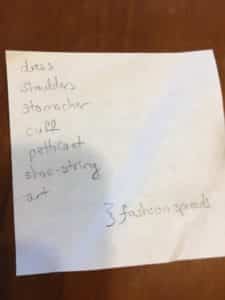I won’t lie: I was daunted to memorize a 371-year-old poem. Up until February the oldest poems I’d tackled were a Yeats from 1890 and a Chesterton from 1896.
So, as I do every afternoon, I went outside to my turquoise bench with my blueberry green tea in the Hawkins Middle School A.V. Club mug from my daughter and began to learn this Renaissance poem by heart.
Delight in Disorder
A sweet disorder in the dress
Kindles in clothes a wantonness;
A lawn about the shoulders thrown
Into a fine distraction;
An erring lace, which here and there
Enthrals the crimson stomacher;
A cuff neglectful, and thereby
Ribands to flow confusedly;
A winning wave, deserving note,
In the tempestuous petticoat;
A careless shoe-string, in whose tie
I see a wild civility:
Do more bewitch me, than when art
Is too precise in every part.
The first thing I noticed is that although the poem is one long stanza, it’s arranged in couplets. The first is an introduction to this “sweet disorder in the dress” and the last one is the thesis, that these disordered clothes “bewitch” the poet more than precise art. Each couplet in between describes a piece of clothing.
Then I knew I could learn it.
Herrick arranges each article of clothing, in — dare I say — a tidy list, from top to bottom. It’s the exact way I arranged descriptions when I fact-checked clothing for a fashion spread. So I noted the order to this poem’s disorder: shoulders, stomacher, cuff, petticoat, shoe-string.
The poem is fourteen lines, but it’s not exactly a sonnet. It is, though, sonnet-ish. It’s a love poem with rhyme, although it’s a little loosey-goosey. It’s also pretty suggestive.
With a poem as old as this one, I’d expected to look up many words, but I only looked up three, and they meant pretty much what I guessed they would. A “lawn” is a shawl made from a particular fabric. A “stomacher” was an undergarment with lots of ornamentation (think of it as the Renaissance version of Spanx, with lace and jewels). “Ribands” is the verb that describes what a ribbon does when it moves.
As I sat with the poem, wearing the least sexy clothes you can imagine — coat, hat, gloves, sweatshirt, tights, festive wool socks — I thought about the woman Herrick seems to be describing. Is she a person or a composite? How many stomachers has he actually seen? Are all petticoats tempestuous? When I read the poem at a monthly poetry group, one woman thought the word “lawn” meant the couple was already rolling around on the grass. I can’t help but wonder if she was more right than she knew.
So who was this fellow with the clothes fetish? In addition to being a poet, Robert Herrick was also an Anglican clergyman (and vicar) who lived from 1591-1674. He never married, which left him free, to, ahem, get around.
He’s the author of the line “Gather ye rosebuds while ye may” from To the Virgins, to Make Much of Time. His poem Upon Julia’s Clothes introduced me to a favorite word: liquefaction, as in “That liquefaction of her clothes.”
Herrick wrote one collection Hesperides. His poetry has become more respected over time. This sentence from the crowd at Wikipedia sums him up rather well: “The over-riding message of Herrick’s work is that life is short, the world is beautiful, love is splendid, and we must use the short time we have to make the most of it.”
In Herrick’s poetry, it’s always Valentine’s Day.
Your Turn
Did you memorize “Delight in Disorder” this month? Join our By Heart community and share your audio or video using the hashtags #ByHeart and #MemoriesWithFriends and tagging us @tspoetry. We also welcome photos of your handwritten copy of the poem.
By Heart for March
For the next By Heart gathering, March 29, we’ll memorize Emily Dickinson’s “I Started Early — Took My Dog —”
I Started Early — Took My Dog —
I started Early – Took my Dog –
And visited the Sea –
The Mermaids in the Basement
Came out to look at me –
And Frigates – in the Upper Floor
Extended Hempen Hands –
Presuming Me to be a Mouse –
Aground – upon the Sands –
But no Man moved Me – till the Tide
Went past my simple Shoe –
And past my Apron – and my Belt
And past my Bodice – too –
And made as He would eat me up –
As wholly as a Dew
Upon a Dandelion’s Sleeve –
And then – I started – too –
And He – He followed – close behind –
I felt His Silver Heel
Upon my Ankle – Then My Shoes
Would overflow with Pearl –
Until We met the Solid Town –
No One He seemed to know –
And bowing – with a Mighty look –
At me – The Sea withdrew –
Photo by frank guido, Creative Commons, via Flickr. Post by Megan Willome, author of The Joy of Poetry.
Browse more By Heart
“Megan Willome’s The Joy of Poetry is not a long book, but it took me longer to read than I expected, because I kept stopping to savor poems and passages, to make note of books mentioned, and to compare Willome’s journey into poetry to my own. The book is many things. An unpretentious, funny, and poignant memoir. A defense of poetry, a response to literature that has touched her life, and a manual on how to write poetry. It’s also the story of a daughter who loses her mother to cancer. The author links these things into a narrative much like that of a novel. I loved this book. As soon as I finished, I began reading it again.”
—David Lee Garrison, author of Playing Bach in the D. C. Metro
- Perspective: The Two, The Only: Calvin and Hobbes - December 16, 2022
- Children’s Book Club: A Very Haunted Christmas - December 9, 2022
- By Heart: ‘The night is darkening round me’ by Emily Brontë - December 2, 2022



L.L. Barkat says
Oh, wow. I totally love your discussion of this poem! I felt a bit intimidated by the Renaissance language myself. And I also couldn’t keep track of where we were clothes-traveling, until I happened to also notice the top to bottom progression. (Oh my. 😉 )
So. At last. It’s mine. (And, therefore, ours as friends!)
Here you go:
https://soundcloud.com/l-l-barkat/delight-in-disorder
Megan Willome says
Yes, ours.